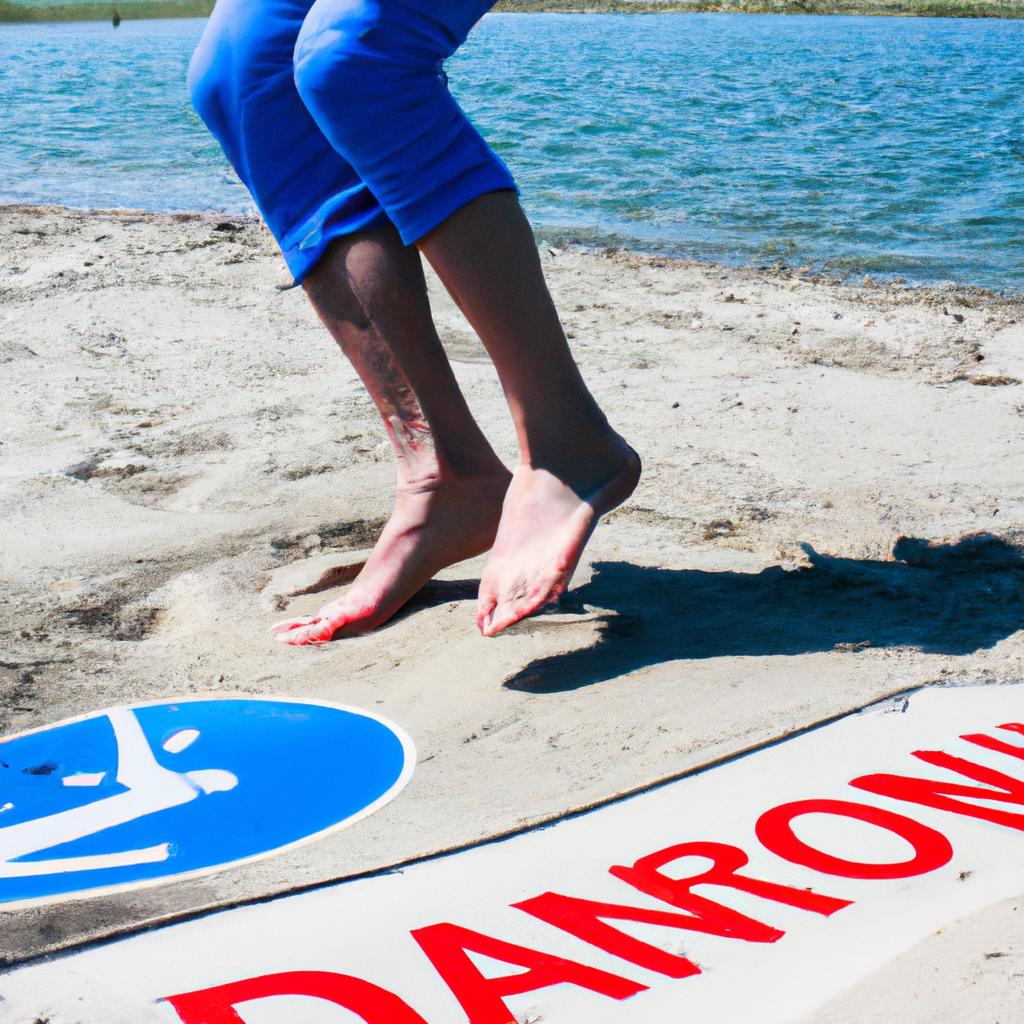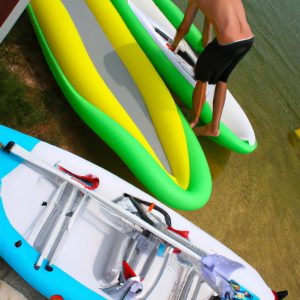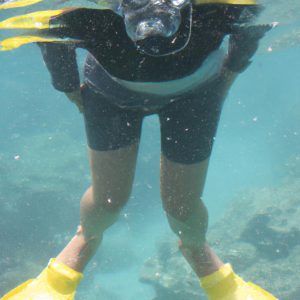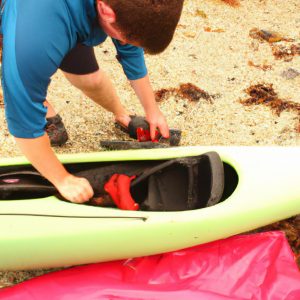Water Safety Guidelines: Ensuring Aqua Sports Safety

One sunny afternoon at a popular beach resort, Sarah, an avid swimmer and water sports enthusiast, decided to try her hand at paddleboarding. Excitedly donning her life jacket and grabbing the paddle, she confidently set out into the calm waters. However, little did she know that within moments, a strong current would sweep her away from the shore and into deeper waters. Struggling against the force of nature, Sarah found herself in a precarious situation where her lack of knowledge on water safety guidelines became all too apparent.
Water-related activities such as swimming, boating, surfing, and kayaking offer endless opportunities for fun and adventure. Nevertheless, it is crucial to prioritize safety when engaging in these aquatic pursuits. Water sports enthusiasts must be equipped with proper knowledge and adhere to established water safety guidelines to avoid accidents or potential dangers. This article aims to explore various essential principles that ensure aqua sports safety by providing practical tips on understanding water conditions, using appropriate safety equipment, following rescue protocols, and enhancing personal awareness during aquatic endeavors. By adhering to these guidelines, individuals can not only enjoy their favorite water activities but also minimize risks and promote overall well-being in aquatic environments.
Understanding the Risks: Common Water Hazards
Understanding the Risks: Common Water Hazards
Imagine yourself enjoying a sunny day at the beach, feeling the gentle breeze and hearing the soothing sound of waves crashing against the shore. As you observe people engaging in various water activities, one incident catches your attention: a young swimmer struggling to stay afloat after being caught in a strong undertow. This example highlights just one of many common water hazards that individuals may encounter during aqua sports or recreational activities.
To ensure safety while participating in water-related activities, it is crucial to understand these risks and how they can potentially jeopardize our well-being. Among the most prevalent water hazards are:
- Rip currents: These powerful narrow channels of fast-moving water flowing away from shore pose significant dangers to swimmers who become trapped within them.
- Drowning: A leading cause of death worldwide, drowning occurs when an individual’s airway becomes blocked by water, preventing respiration.
- Collision accidents: In crowded swimming areas or busy boating zones, collisions between vessels or individuals can result in severe injuries or even fatalities.
- Marine life encounters: Interactions with marine creatures such as jellyfish stings, sea urchin punctures, or shark attacks can lead to painful injuries requiring immediate medical attention.
By understanding these risks associated with aqua sports and recreational activities, we can take appropriate measures to mitigate potential harm. To further illustrate their impact on personal safety and evoke an emotional response, let us consider the following table:
| Hazard | Consequence | Prevention Measures |
|---|---|---|
| Rip currents | Swimmer pulled out to sea | Swim parallel to shore |
| Drowning | Loss of consciousness | Learn CPR skills |
| Collision accidents | Broken bones and head trauma | Observe speed limits |
| Marine life encounters | Painful wounds and infections | Wear protective clothing and equipment |
Recognizing these hazards allows us to make informed decisions, adopt suitable preventive measures, and equip ourselves with the necessary knowledge. By doing so, we can minimize the risks associated with water activities and ensure a safer experience for everyone involved.
Transitioning into the subsequent section about “Choosing the Right Equipment: Safety Gear Essentials,” it becomes evident that understanding common water hazards is just one step towards ensuring our safety in aqua sports.
Choosing the Right Equipment: Safety Gear Essentials
Now that we have explored the various risks associated with water activities, let us delve into an essential aspect of ensuring safety while participating in aqua sports – choosing the right equipment. By selecting appropriate safety gear, individuals can significantly reduce the likelihood and severity of accidents or injuries.
To illustrate this point, consider a hypothetical scenario where two individuals decide to go kayaking without proper protective gear. While one individual wears a life jacket and helmet, the other neglects these items. Unfortunately, they encounter rough waters unexpectedly, causing their kayak to capsize. The person wearing the appropriate safety gear is able to stay afloat and protect their head from potential injuries, whereas the other person faces considerable difficulties due to lack of protection.
When it comes to selecting safety gear for water activities, there are several key essentials that should never be overlooked:
- Life Jackets or Personal Flotation Devices (PFDs): These devices provide buoyancy and keep individuals afloat in case of accidental submersion or loss of control.
- Helmets: Particularly important for water sports involving high speeds or potential collisions such as jet skiing or wakeboarding.
- Wetsuits: Designed to provide thermal insulation and protection against cold water temperatures.
- Footwear: Non-slip footwear helps maintain stability on slippery surfaces and protects feet from sharp objects underfoot.
By consistently utilizing these crucial pieces of equipment while engaging in aqua sports, individuals can enhance their personal safety and minimize risks associated with water-related activities.
In order to further emphasize the importance of choosing suitable safety gear for aquatic endeavors, let us look at a comparative table outlining different scenarios based on whether proper equipment was utilized:
| Scenario | Proper Safety Gear Used | No Safety Gear Used |
|---|---|---|
| Kayaking in calm waters | Enjoyable experience | Increased risk |
| Jet skiing at high speeds | Safe and thrilling | Potential hazards |
| Snorkeling in coral reefs | Enhanced exploration | Vulnerable to injury |
| Wakeboarding at the lake | Exciting and secure | Prone to accidents |
As evidenced by the table above, investing in appropriate safety gear significantly enhances the overall experience while also mitigating potential dangers.
In light of this information, it is crucial for individuals engaging in water sports to prioritize their safety by selecting suitable equipment. By doing so, they can ensure a more enjoyable and risk-free experience, allowing them to fully embrace aqua sports with peace of mind.
Transitioning into the subsequent section about “Knowing Your Limits: Assessing Your Swimming Skills,” let us now explore how understanding our swimming capabilities plays an integral role in maintaining personal safety during water activities.
Knowing Your Limits: Assessing Your Swimming Skills
With the right safety gear in place, it’s important to assess your swimming skills before engaging in any aqua sport activities. Knowing your limits can help prevent accidents and ensure a safe experience in the water.
Assessing Your Swimming Skills
To illustrate the importance of assessing one’s swimming abilities, let’s consider a hypothetical situation involving John—an individual who has recently taken up paddleboarding but is not an experienced swimmer. While out on his board, John loses balance and falls into the water. Without strong swimming skills, he struggles to stay afloat and reach safety. This scenario emphasizes why understanding your own capabilities is crucial in preventing dangerous situations when participating in aqua sports.
When evaluating your swimming skills, keep these key considerations in mind:
- Proficiency level: Determine whether you are a beginner or have intermediate/advanced proficiency in swimming.
- Stamina: Assess how long you can comfortably swim without feeling exhausted or short of breath.
- Water confidence: Evaluate your comfort level in different water conditions such as pools, open waters, or rough seas.
- Specific strokes: Identify which swimming strokes you are proficient at and if there are any that need improvement.
By taking stock of these factors, individuals can make informed decisions about their participation in various aqua sports activities based on their personal skill sets and limitations.
Additionally, it is essential to underline the significance of recognizing potential hazards associated with different aqua sports. The following table highlights four common risks and corresponding preventive measures:
| Risk | Preventive Measure |
|---|---|
| Drowning | Always wear a life jacket |
| Hypothermia | Dress appropriately for cold-water activities |
| Sunburn | Apply waterproof sunscreen |
| Injuries from impact | Wear appropriate protective gear |
Emphasizing safety precautions through visual aids like tables helps create awareness among readers by evoking an emotional response towards ensuring their well-being.
Having a swimming partner can provide an extra layer of protection and enhance overall safety during aqua sports activities.
Buddy System: Importance of Having a Swimming Partner
Building on the importance of assessing your swimming skills, another crucial aspect of water safety is ensuring that you have a buddy to accompany you during aqua sports activities. The buddy system provides an added layer of security and support, reducing potential risks and enhancing overall safety.
Section H2: Buddy System: Importance of Having a Swimming Partner
The significance of having a swimming partner cannot be overstated. Consider this hypothetical scenario – two friends decide to go snorkeling in unfamiliar waters without a buddy. One friend encounters difficulty due to strong currents but has no one nearby who can offer immediate assistance. In such situations, having a swimming partner could mean the difference between life and death. Here are some key reasons why the buddy system is essential:
-
Increased vigilance:
- A swimming partner can help keep an eye out for any signs of distress or danger.
- They can alert lifeguards or other individuals if necessary, ensuring prompt assistance when needed.
-
Mutual support:
- Engaging in aqua sports with a buddy creates a sense of camaraderie and shared responsibility.
- If one person faces difficulties, their companion can provide physical or emotional aid, fostering trust and reassurance.
-
Emergency response:
- Accidents can happen unexpectedly, even to experienced swimmers or divers.
- With a buddy present, there is someone readily available to assist in case of emergencies, potentially preventing further harm.
-
Risk reduction:
- By adhering to the buddy system, the likelihood of becoming disoriented, lost, or separated from your group decreases significantly.
- Together, partners can navigate through challenging conditions more effectively than if they were alone.
Table: Common Aqua Sports Activities
| Activity | Risk Level | Appropriate Buddy System |
|---|---|---|
| Snorkeling | Moderate | Mandatory |
| Kayaking | Low | Highly Recommended |
| Surfing | High | Essential |
| Scuba Diving | Very High | Mandatory |
In conclusion, the buddy system plays a vital role in ensuring water safety during aqua sports activities. By having a swimming partner, individuals can enhance their vigilance, provide mutual support, respond to emergencies efficiently, and reduce potential risks. However, another critical aspect of water safety is being mindful of weather conditions before engaging in any water-based activities.
Understanding the importance of assessing your swimming skills and having a reliable swimming partner, it is equally essential to be aware of weather conditions before participating in aqua sports. Let’s delve into the next section on “Weather Watch: Checking Conditions before Water Activities.”
Weather Watch: Checking Conditions before Water Activities
Building on the importance of having a swimming partner, it is crucial to also consider external factors that can impact water safety. In order to fully enjoy aqua sports activities while minimizing risks, it is essential to be aware of and monitor weather conditions before engaging in any water-based adventures.
Weather Watch: Checking Conditions Before Water Activities
Imagine this scenario: A group of friends plans an exciting kayaking trip along a local river. They eagerly gather their gear, prepared for a day filled with adventure. However, as they arrive at the launching point, dark clouds begin to form overhead and distant thunder rumbles through the air. Ignoring these warning signs, they proceed with their plan, unaware of the potential dangers ahead.
To prevent such situations and ensure your safety during water activities, here are some guidelines for checking weather conditions:
- Consult reliable sources such as meteorological websites or apps specialized in providing real-time weather updates.
- Pay attention to weather warnings issued by authorities, including storm advisories or flash flood alerts.
- Familiarize yourself with common symbols used in weather forecasts to understand predicted conditions better.
- Observe changes in wind patterns and cloud formations directly at the location before entering the water.
Table: Weather Symbols Guide
| Symbol | Meaning |
|---|---|
| ☀️ | Sunny |
| 🌤️ | Partly cloudy |
| ⛅ | Mostly cloudy |
| 🌧️ | Rainy |
By following these steps and being proactive about monitoring weather conditions, you not only enhance your personal safety but also contribute to creating a more responsible aqua sports culture where everyone can enjoy outdoor activities without unnecessary risks.
Transition sentence into next section:
With proper knowledge of weather conditions established, another critical aspect of ensuring aquatic sports safety comes from being equipped with emergency preparedness skills. This includes knowing how to administer first aid and perform CPR if necessary, which will be discussed in the following section on “Emergency Preparedness: First Aid and CPR Training.”
Emergency Preparedness: First Aid and CPR Training
Having discussed the importance of checking weather conditions before engaging in water activities, it is equally crucial to be prepared for any emergencies that may arise. In this section, we will focus on emergency preparedness, specifically highlighting the significance of first aid and CPR training.
Section:
Example (Case Study):
Imagine a scenario where an individual participating in a swimming competition suddenly experiences difficulty breathing due to an accidental collision with another swimmer. The quick response by a trained lifeguard who administers CPR helps stabilize the victim until professional medical assistance arrives. This example illustrates how proper knowledge and application of first aid techniques can greatly impact the outcome of such incidents.
First Aid and CPR Training:
To ensure safety during aqua sports activities, individuals are encouraged to undergo comprehensive first aid and cardiopulmonary resuscitation (CPR) training. Here are key reasons why such training is vital:
- Immediate Response: Knowing how to administer basic first aid measures promptly can significantly minimize injury severity while awaiting professional help.
- Life-Saving Techniques: Properly applying CPR techniques can revive individuals experiencing cardiac arrest or respiratory distress, boosting their chances of survival.
- Enhanced Awareness: First aid and CPR training increase awareness about potential risks associated with water sports, enabling participants to respond effectively during emergencies.
- Empowerment: Equipping oneself with these life-saving skills fosters confidence when engaging in water activities and encourages others to prioritize safety as well.
Table – Common First Aid Techniques:
| Technique | Description | Importance |
|---|---|---|
| Wound Cleaning | Thoroughly cleaning wounds reduces infection risk | Prevents complications |
| Fracture Immobilization | Stabilizing fractured bones minimizes further damage | Prevents additional injuries |
| Choking Maneuver | Performing the Heimlich maneuver dislodges obstructions | Restores normal breathing |
| AED Usage | Proper use of an Automatic External Defibrillator | Restarts heart rhythm in cardiac arrest situations |
Bullet Point List – Emotional Response:
- Ensure the safety and well-being of yourself and others
- Minimize potential harm and injuries during water activities
- Increase chances of survival in emergency situations
- Foster a culture of preparedness and responsibility
Conclusively, it is crucial for individuals engaging in aqua sports to prioritize their own safety as well as that of others. Through first aid and CPR training, one can acquire life-saving skills that contribute significantly to mitigating risks associated with water-related emergencies. By being proactive in emergency preparedness, we enhance our ability to respond effectively when unexpected incidents occur.






